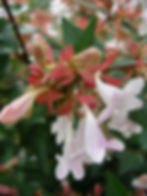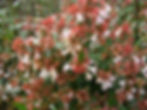Five Shrubs to drive Bees and other Pollinators Wild!
- iPlantsman
- Aug 17, 2022
- 6 min read
Here are five of the best hardy shrubs for temperate gardens to attract Bees and other Pollinator to your garden.
Everyone by now knows the value of Bees, Hoverflies, Butterflies and other pollinating insects in ensuring fruit crops produce the fruit we need to sustain human life on the planet. While not everyone (yet) truly values bees and these other vital pollinators, those in the know want to do their best to help secure their future in an ever-changing and often insect-unfriendly world. One way we can help is to reduce our use of potentially harmful and insecticidal chemicals. Another is to include some plants in our gardens that are both great for us and equally great for these glorious insects. These are my favourite five of the moment (in no particular order).
1.

Hebe 'Midsummer Beauty'
Not just one of the best insect attracting shrubs for the temperate garden, but one of my most favourite plants altogether. Anyone who knows me, knows that I love Hebes, this is one of the all-time greats. A larger shrub to 1.8m (6') and generally wider, this sun-loving plant produces 20cm (8") long racemes of flowers through summer. It is evergreen with young foliage being pleasantly purple-tinged. Pretty hardy throughout the UK, but inland and in exposed gardens a warm, sunny spot will make all the difference in protecting the foliage and ensure good flowering. Like all Hebe, it dislikes winter wet and it is often a little weaker and less fulsome for the first couple of seasons after planting. This will sort itself in time and in a favourable spot, this is a hugely impressive plant and can even be grown as an informal hedge. When it is good, it is so very good!
2.

Buddleja davidii 'White Profusion'
Buddleja aren't called Butterfly bushes for nothing! Large plants can often have hundreds of visits each day from Butterflies, Bees, Hoverflies, Day-flying Moths and more. Even at night, Moths, who are arguably the real unsung heroes of plant pollination will visit Buddlejas for nectar. Buddleja davidii 'White Profusion' is just one good variety and in my experience any Buddleja in a garden will be a popular nectar spot, but I list it as it is a good doer, with silvery-grey foliage and a pure white flower. It is also readily available to buy. If space is of a premium, much of the newer varieties have been bred to be more compact, so look out for any variety with 'Nanho' in the name, or plants from the Candy Lila and Candy Little series, as well as the Flutterby series, plus others, all of which are compact and lower growing than older varieties. The only downside to white flowered Buddleja, like many white flowered plants, is that as each flower goes over, it turns noticeably brown. If you can't take that, there are Pink, Purple, Blue and almost Red forms available, where this colour change is less noticeable. Plant in full sun and in well-drained soil for best growth. Buddleja do very well on really quite poor soil and are commonly seen growing out of cracks in the brickwork of abandoned building, derelict sites and wasteland. A true survivor. My best advice is to prune Buddleja to maintain size and shape. I experiment to great results with cutting back a substantial plant of Buddleja davidii to one third of its original size in Feb/March. It put on long, straight growth and flowers were later to arrive, starting in July, but were twice the size that they were on an unpruned plant. Worth an experiment I'd suggest.
Below are some images of Buddleja davidii 'White Profusion' with Bumblebees (Bombus sp) and with Peacock Butterflies (Aglais io). Lilac coloured Buddleja davidii seedling with Jersey Tiger Moth (Euplagia quadripunctaria) in Northern France.
3.

Berberis darwinii
Darwin's Barberry is one of the most striking shrubs of Spring. The purity and intensity of the orange coloured flowers, red peduncle and pedicels (flower stalks) and glossy, deep-green, spikey foliage all stand out making this easy to identify and a delight to behold. Full disclosure, these flowers are really rather small at only 5mm (1/5 of an inch), but are produced in abundance over the plant and are a great source of early shrubby nectar for insects on the wing in March/April. The spiny leaves and thorns on the stems make it a useful boundary plant, or one for under ground-floor windowsills to beef up home security. Grows well in sun or shade, but if find it at its most striking in light shade, where it appears to glow, even on dull days. It will grow to around 1.5m (5') tall and perhaps a little bit wider. After flowers, fruit is formed ripening over the summer. Birds and mammals in the garden will eat these in autumn, making it doubly wildlife friendly.

4.

Chaenomeles x superba 'Pink Lady'
There are many flowering quince varieties available and I'm yet to find one that was difficult to grow or a poor flowerer. Red, Pink, White, Salmon-Orange and even Green flowered forms are available to buy, in both single and double flowered forms. Pink Lady is a tried and tested pink-flowered variety, that is easy to grow, performs well and is popular with early flying insects, flowering as it does from February to April. Flowers are typically single, but are occasionally semi-double on this variety in my experience. After flowers, hard, green fruits are produced, which ripen to yellow. They are edible, but really need to be cooked into preserves as you are likely to lose a tooth trying to gnaw your way through a raw fruit. The first flush of flowers is produced on bare winter stems, but most years, there will be a July-August secondary flush of flower though it can be lost a little among the foliage. Autumn colour before leaves fall is reasonable, if not show-stopping and generally in shades of yellow. This plant makes an excellent wall-trained plant, grown, pruned and tied to wires or trellis and with growth not pruned back after July allowing it to set flower for the following spring. Sleepy Bumblebees in particular visit this plant when they have woken following winter.

5.

Abelia x grandiflora
Another favourite shrub and for good reason! Flowers are produced in abundance, reliably between April and October and I have seen plants in very sheltered spots that just forgot to stop for winter. It is semi-evergreen and pretty hardy; this means that in cold winters or exposed spots, it will lose between some and a lot of leaves. The more sheltered the spot, the better the performance, so it is worth seeking out a warm spot, away from frost pockets and exposure to the wind if at all possible. One thing it will not tolerate is sitting in water, so ensure your soil has reasonable drainage. If you can provide this you will get a fantastic plant with arching brown stems, glossy green leaves, palest pink, witches-hat-shaped flowers and the wonderful reddish calyxes you can see on the image above and below. When not in flower, these calyxes persist giving the appearing of flower and extra interest. Often an ugly duckling young plant sitting lop-sided in a pot on a nursery, it takes a couple of years until you get the long stems forming and the fountain-like arching form. I've seen it clipped to mound shapes, trained against walls and even roughly shaped with a hedge-trimmer. It seems happy enough with all of these techniques, or none at all. If you want to get an arching shape, remove whole stems with secateurs rather than trim the plant all over, which seems to change the way in which it chooses to grow. Height of up to 1.5m (5') as a freestanding shrub in the UK, I suspect it is capable of a good bit more. Normally wider than it is tall. Lots of decent variegated forms available now, though most are smaller plants. I like this hybrid species and always have it in every garden I own. Bees in particular can be watched dipping into each flower as they do on Foxgloves (Digitalis sp.), happily gathering and transferring pollen, while searching for nectar.

Happy Gardening

#Bees #Bumblebees #Butterflies #Moths #DayflyingMoths #PeacockButterfly #Aglaisio #JerseyTigerMoth #Euplagiaquadripunctaria #Bombus #Hoverfly #Hoverflies #Buddleja #Hebe #Hebes #HebeMidsummerBeauty #Buddlejadavidii #BuddlejaWhiteProfusion #Berberis #Berberisdarwinii #Abeliaxgrandiflora #Abelia #Chaenomeles #ChaenomelesPinkLady #Pink #White #Colour #Flowers #Shrubs #Shrubsforinsects #Shrubsforpollinators #pollinatorplants #pollinators #topfive #topfiveshrubs #topfiveshrubsforinsects #plantsforbees #plantsforbutterflies #plantsformoths #plantsforhoverflies #plantsforinsects #spinyplants #thorns #intruderdeterrent #homesecurity #orange #red #blue #purple #green #hardyplants #temperategardens #ukgardens #ukgardening #plantingdesign #toughplants
















